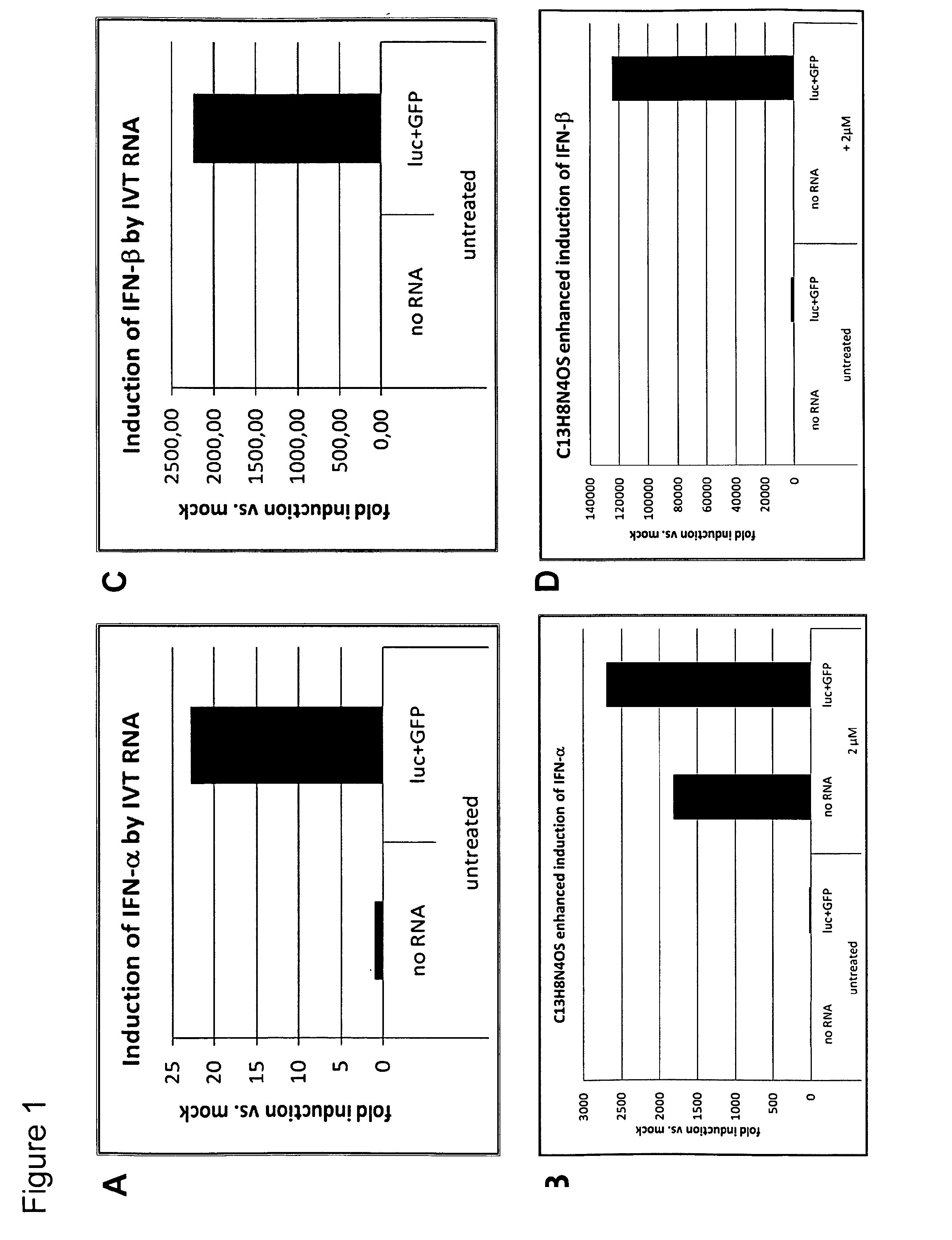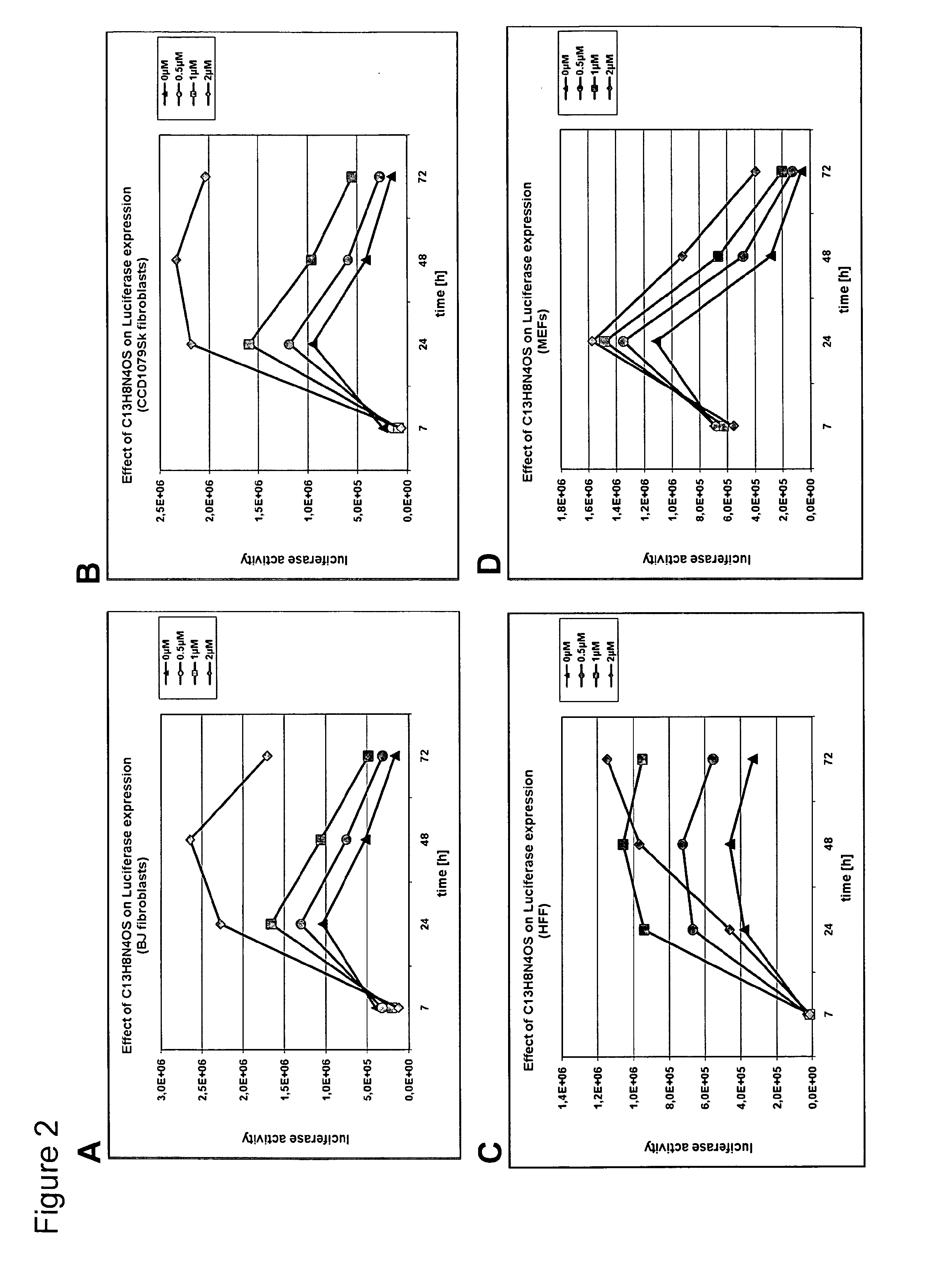Method for Cellular RNA Expression
a cellular rna and expression technology, applied in the field of enhancing rna expression, can solve problems such as rna stability, and achieve the effect of reducing the activity of rna-dependent protein kinase (pkr)
- Summary
- Abstract
- Description
- Claims
- Application Information
AI Technical Summary
Benefits of technology
Problems solved by technology
Method used
Image
Examples
example 1
[0273]Cell Culture
[0274]Primary human newborn foreskin fibroblasts (CCD-1079Sk, CCDs), BJ human neonatal foreskin fibroblasts were obtained from ATCC (Manassas, Va., USA) and cultivated in MEM (Invitrogen, Karlsruhe, Germany) supplemented with 10% heat-inactivated fetal bovine serum gold (PAA Labratories, Pasching, Austria), 1× non-essential amino acids (Invitrogen), 1 mM sodium pyruvate (Invitrogen), 2 mM glutamine (Invitrogen), 50 U / ml penicillin (Invitrogen) and 50 μg / ml streptomycin (Invitrogen). Another charge of human neonatal foreskin fibroblasts (HFF) were obtained from SBI (Mountain View, Calif., USA) and cultivated similar to CCDs and BJs. Murine embryonic fibroblasts (MEFs) were isolated from 14 days old C57BL / 6 mice embryos and cultivated in DMEM (Invitrogen) supplemented with 15% heat-inactivated fetal bovine serum, 1× non-essential amino acids, 1 mM sodium pyruvate, 2 mM glutamine, 50 U / ml penicillin and 50 μg / ml streptomycin. Human epidermal keratinocytes were obtaine...
example 2
[0297]Primary human foreskin fibroblasts (CCD1079SK) were electroporated with 1 μg IVT RNA encoding for firefly luciferase and 5 μg IVT RNA encoding for destabilized GFP (luc+GFP). Electroporations were performed in 2 mm gap cuvettes using optimized parameters. The cells were plated in 6-well-plates at a density of 300000 cells / well and either left untreated or incubated with 2 μM C13H8N4OS (PKR-inhibitor). 24 h later cells were harvested for total RNA extraction and reverse transcription. The induction of type-I interferons was assessed by qRT-PCR using specific primer for IFNα or IFNβ in the presence or absence of PKR-inhibitor as indicated in FIG. 1. Panels A and C show the same samples as B and D with reduced values of the y-axis.
[0298]Upregulation of interferon transcripts in human fibroblasts induced by RNA electroporation was observed (FIGS. 1A and 1C). Surprisingly, the inhibition of PKR using C13H8N4OS resulted in an overwhelming increase of interferon transcripts (FIGS. 1B...
example 3
[0299]Human and mouse primary fibroblasts were electroporated with IVT RNA encoding the reporter genes firefly luciferase and GFP. Electroporations were performed in 2 mm gap cuvettes using optimized parameters for each cell type. Immediately after electroporation the cells were plated in absence or presence of increasing concentrations of the C13H8N4OS PKR-inhibitor.
[0300]As depicted in FIGS. 2 and 3 a dose dependent increase of the reporter genes luciferase and GFP in human and mouse fibroblasts was observed. In the presence of the highest concentration used (2 μM), a high level of stabilization of luciferase and GFP expression was observed.
PUM
| Property | Measurement | Unit |
|---|---|---|
| half life | aaaaa | aaaaa |
| time | aaaaa | aaaaa |
| time | aaaaa | aaaaa |
Abstract
Description
Claims
Application Information
 Login to View More
Login to View More - R&D
- Intellectual Property
- Life Sciences
- Materials
- Tech Scout
- Unparalleled Data Quality
- Higher Quality Content
- 60% Fewer Hallucinations
Browse by: Latest US Patents, China's latest patents, Technical Efficacy Thesaurus, Application Domain, Technology Topic, Popular Technical Reports.
© 2025 PatSnap. All rights reserved.Legal|Privacy policy|Modern Slavery Act Transparency Statement|Sitemap|About US| Contact US: help@patsnap.com



